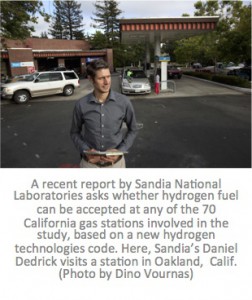Researchers at Sandia National Laboratories have published a study that found a number of existing gas stations in California can safely store and dispense hydrogen. This, the researchers suggest, a broader network of hydrogen fueling stations may be within reach.
The report examined 70 commercial gasoline stations throughout California and sought to determine which, if any, could integrate hydrogen fuel, based on the National Fire Protection Association (NFPA) hydrogen technologies code published in 2011. The report found that 14 of the 70 gas stations considered in the study could readily accept hydrogen fuel and that 17 more possibly could accept hydrogen with property expansions.  Under previous NFPA code requirements from 2005, none of the existing gasoline stations could readily accept hydrogen. The current code, known as NFPA 2, provides fundamental safeguards for the generation, installation, storage, piping, use and handling of hydrogen in compressed gas or cryogenic (low temperature) liquid form.
Under previous NFPA code requirements from 2005, none of the existing gasoline stations could readily accept hydrogen. The current code, known as NFPA 2, provides fundamental safeguards for the generation, installation, storage, piping, use and handling of hydrogen in compressed gas or cryogenic (low temperature) liquid form.
Sandia Hydrogen Program Manager Daniel Dedrick said the development of meaningful, science-based fire codes and determinations such as those found in the report will help accelerate the deployment of hydrogen systems. “This work shows that we can reduce uncertainty and avoid overly conservative restrictions to commercial hydrogen fuel installations by focusing on scientific, risk-informed approaches. It turns out that the number of fueling stations able to carry hydrogen can be quantified.” Dedrick added, “We now know that we can build more hydrogen fueling stations if we examine the safety issues within a sound, technical framework that focuses on the real behaviors of hydrogen.”
Sandia’s hydrogen safety, codes and standards program is a diverse portfolio of activities funded by the Department of Energy’s Fuel Cell Technologies Office to provide the technical basis for developing and revising safety codes and standards for hydrogen infrastructure, including the NFPA 2 code. This work is aligned with Hydrogen Fueling Infrastructure Research and Station Technology (H2FIRST), a new project established by the Department of Energy’s Office of Energy Efficiency and Renewable Energy.

